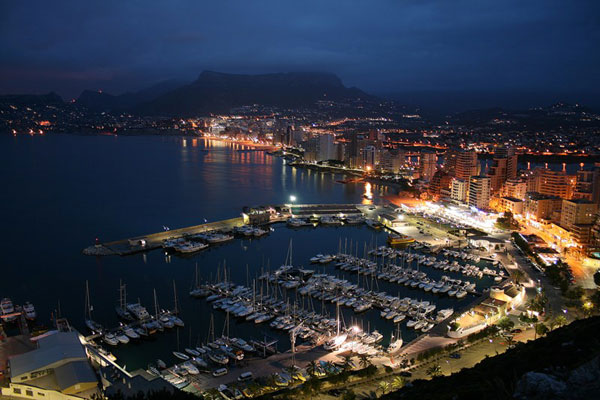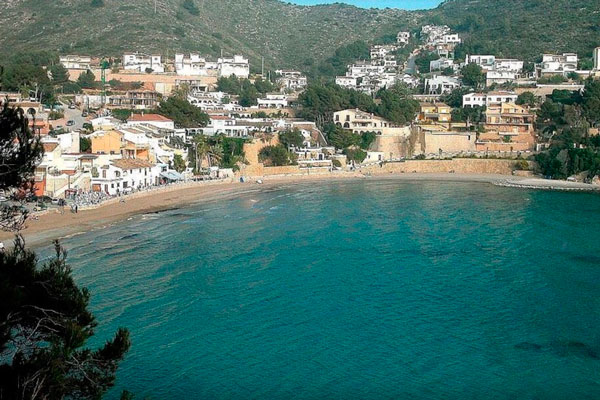Location
The Neighourhood
Chris’s home is located in Teulada, Comunidad Valenciana, Spain.
Villa Andres is located a short walk (4 minutes) to a popular local bar and restaurant. A selection of other restaurants including French, Italian, Indian and Spanish are some 12 minutes walk (800m) away. The nearest beach is a 12 minutes walk or 3 minutes in the car.
Some say that Moraira is the jewel of the Costa Blanca with its low rise, under developed green hills and has been compared to St Tropez. Moraira is a fishing village nestled on the coast and benefits from being a small, charming and well looked after village with its cobbled street where you will find the typical Spanish fish market just besides the marina. There are plenty of little terraces and view points to keep you wanting more spotted all over the village and over towards the sought after area of El Portet. If you take the road from Moraira over to El Portet you benefit from a truly breathtaking view all the way to the Ifach rock.
Learn more »
Every Friday Moraira hosts one of the biggest markets on the Costa Blanca, in a large car park near the Centro de Salud. You will find a huge array of locally grown fruit and vegetables, and if you want to take a paella pan home, no problem! You will find it here alongside shoes, shampoo, spices and swimming gear! There is also a smaller, more traditionally Spanish market every Wednesday in nearby Teulada, which is actually the old town of Moraira. For more shopping wander around the backstreets of Moraira and you will find interesting jewellery shops, top-label designer boutiques, good leather shops and some art galleries.

The Moraira region has more than 1,000 hectares of vineyards and is famous for growing Muscatel grapes for wine-making as well as dessert grapes and raisins. The vineyards tend to be up in the hills where the land is cheaper and the climate is a little cooler. The San Vicente Ferrer Cooperative makes excellent mixtures such as Villa Teulada white wine and sweet Muscatel. Do try some before you go home! There is a Moscatel Festival in early September.

You are spoilt for choice for days out from your Moraira villa. One option would be Calpe, a popular, bustling resort 8 miles south of Moraira. Calpe is dominated by the extraordinary, dramatic rock which rises 332 meters out of the Mediterranean Sea, standing guard over the town. This famous landmark can be seen for miles! Since 1987 it has been a nature reserve providing a protected environment for a variety of birds and unusual flora and fauna. If you are superfit, you could try walking to the very top of the rock? There is a walking route which goes through a tunnel. The town has three Blue Flag beaches, a busy harbour, great restaurants, shops, bars and night-time entertainment.
By way of contrast, if you would like a break from driving, take the tram, running along the Costa Blanca, between Alicante and Denia. Jump on a tram to either Gata de Gorges or go a little further to Denia for a day out. To get to Alicante you change trams at Benidorm. The trams run every hour. You can sit in comfort and marvel at the wonderful west Mediterranean landscape.
Beaches
For families with small children in search of services and comfort, the best beach is the Playa de L'Ampolla, lying just beneath Moraira Castle. Although it may be the busiest beach, it is also the biggest one, and in summer it has lots of services: amphibious chairs for the disabled, life guards, surveillance, walkways, toilets, a playground for kids, a restaurant? In spite of its being so busy, that shouldn't make you think it lacks charm - far from it. Just a hop, skip and a jump away, and well worth the visit, is the Marjal del Senillar, a coastal wetland with lakes, shores and dunes that provide shelter for animals and plants at risk of extinction, particularly the highly colourful Spanish toothcarp, a very rare species of fish. The beach restaurant has a paying car park, or you can park free in the main Moraira car park, which is only a few hundred metres away. The streets of Moraira are pay and display parking.

La Calaÿa small rocky beach of clear waters and is difficult to access - get here either either by boat or by walking along the cliff. Torre Cap d'Dorÿcan be reached on foor from El Portet

Playa del Portet. It is a small shell shaped inlet, with clear waters and a sandy beach, and is a superb setting for a peaceful swim. There are a number of small bars and restaurants along the front along with showers and a parking area.
Moving on to the two bays at Platgetes, whose water is amazingly clean, we come across alternating areas of sand and rock. Accessible no matter what the time of year, a convenient landscaped promenade provides visitors with numerous viewpoints. The bays at Portitxol, L'Andrag¢ and Cap Blanc are all worthy of mention. They are all perfect for diving and fishing. The second of the three bays is particularly famous for the depth of its waters, ideal for a really interesting dive. An ideal plan for a day out would be to walk along the path that runs between the L'Andrag¢ cove and Cap Blanc, stopping off at all the viewpoints along the way to enjoy the incredible panoramas they offer.
Address
Calle Rio Ter, 20
03724 Teulada
Alicante
Spain
GPS
Getting Around
A car is not absolutely essential as the Villa has a great location and as a result, all facilities are within walking distance. However a car would be recommended as it can get very hot in the summer months.
History
Moraira castle, built in the 18th century, rises up just beside this sandy area. Built by the Bourbons, this building contains a level that is referred to as the "ox's hoof". Laid out in a semicircle, its function, as was the case in other constructions of that time, was to protect the inhabitants from invasion by Barbary Coast pirates. Sailing from Tunisia, Tripoli, Algeria and Morocco, not only did those corsairs board ships, they would frequently invade inland areas in search of Christian slaves that they would then sell for profit.
Learn more »
Spectacular beaches and a unique Gothic walled city centre: Immerse yourself in its culture and enter into contact with its surprisingly green and unspoilt natural environment: Moraira-Teulada has all the ingredients you need for a few days of genuine relaxation. In actual fact, the municipality ? it only has some 14,000 inhabitants, comprises two urban centres, that of Moraira, on the shores of the Mediterranean, and inland Teulada. Together they have more than 8 kilometres of spectacular coastline to offer the visitor.
Towards the end of the 19th century, Teulada was little more than a small farming village. The farmers would take any excess produce down to the nearby natural port of Moraira, to sell it to boatmen who would call in there. At that time Moraira was no more than a few small shacks that fishermen from Teulada would build here and there, so as to have somewhere to store their tackle. As the years went by, these primitive constructions were transformed into the homes of these workers and their families, and decades later they turned into the important coastal tourist centre that we know today.
Moraira's historic roots as a fishing village are still in evidence; its fish market is one of the most popular in the Costa Blanca region and the port has five fishing boats in operation. The Moraira region is also famous for the growing of Muscatel grapes for wine-making.
Lovers of history can enjoy lazy evenings strolling through the Gothic Walled Town of Teulada, declared an Asset of Cultural Interest ("BIC") under the category of Historic Site. Known as "La Villa", its origins lie in the era immediately after the Christian Reconquest of Spain, and it offers stately homes built in stone, religious monuments typical of the late Gothic period in Valencia although there are also certain Baroque, and albeit fewer but of interest nonetheless, modernist elements. The Fortified Church of Santa Catalina and the Hermitage of the Divine Shepherd cannot be left out of this cultural tour of the city.
The Playa del Portet provides calm and crystal clear water, far from the madding crowd. This is in fact the ideal starting place for the more adventurous as from this fine sandy beach you can begin to climb up to the cape's watchtower, which forms part of the Community of Valencia's Micro-Reserves Network.
The tower dates back to the 16th century and, together with the nearby fortified Church of Santa Catalina, Moraira Castle and the neighbouring towers at Javea and Calpe, it was at that time an original and effective protection system. Not far away, the Cova de Cendra makes for an interesting excursion. This archaeological site dates back to the Upper Palaeolithic period.
However, the economy of Moraira is now built around tourism that have transformed the coastline over the past 30 years. Strict planning regulations have prevented over development and high rise buildings, making it a highly desirable destination. Little cobble streets show the remains of the fishing cottages that once made up the little port that serviced the town of Teulada that stands at the head of the valley. To preserve the heritage of the area, the Teulada council passed laws protecting the abundant pine trees and limited the height of buildings. It has a privately owned marina built in 1985, operated by Club N utico Moraira. Moraira is also seen as a culinary destination, with many restaurants.
Gastronomy
In recent years numerous restaurateurs and wine producers in Teulada-Moraira have managed to make a name for themselves in the competitive gastronomy scene in the Levante. The mark of quality, "Bah¡a de Moraira" has become firmly established as a benchmark for fish that are caught by fishermen using traditional fishing skills.
Learn more »
Such fish is of course the main ingredient on the typical recipes you can enjoy in Teulada such as "putxero de polp" (octopus stew), "sopa de peix" (fish soup), or salted bullet tuna or anchovies. Of course, as is the case throughout the province of Alicante, rice is to the fore. Rice "a banda", rice with fessols i naps (beans and turnip), paella with sardines and spinach and "black" rice, preside over tables that are proud to serve traditional cuisine based on excellent local ingredients. "Arroz meloso de pulpo" (a moist rice and octopus dish) or oven-cooked rice meet with the approval of even the most exquisite gourmands.
As far as vegetables are concerned, the local "Cocido" (a typical boiled stew) with meat balls wrapped in cabbage leaves, or rice with dried beans, are popular. Nor should we forget the marvellous home-made cold meats, for example, a soft salami known as "sobrasada", "blanquet", "longanissa" (a long pork sausage) and "butifarra", a typical Catalan sausage. Among the different seafood on offer, you should try the local limpets and the exquisite sea urchins.
Of course, such a menu deserves more than just a run-of-the-mill wine. The white wines they produce in Teulada-Moraira, such as "Vina Teulada", are imbued with the aromas of Mediterranean flowers, and the lighter wines such as "La Marina", provide a sparkle that combines perfectly with fish dishes. Generally speaking, the area's Muscatel grape is well treated by expert farmers and magnificent wine producers and gives rise to the most prestigious wine and "mistela" liqueur that you will find anywhere in Alicante.